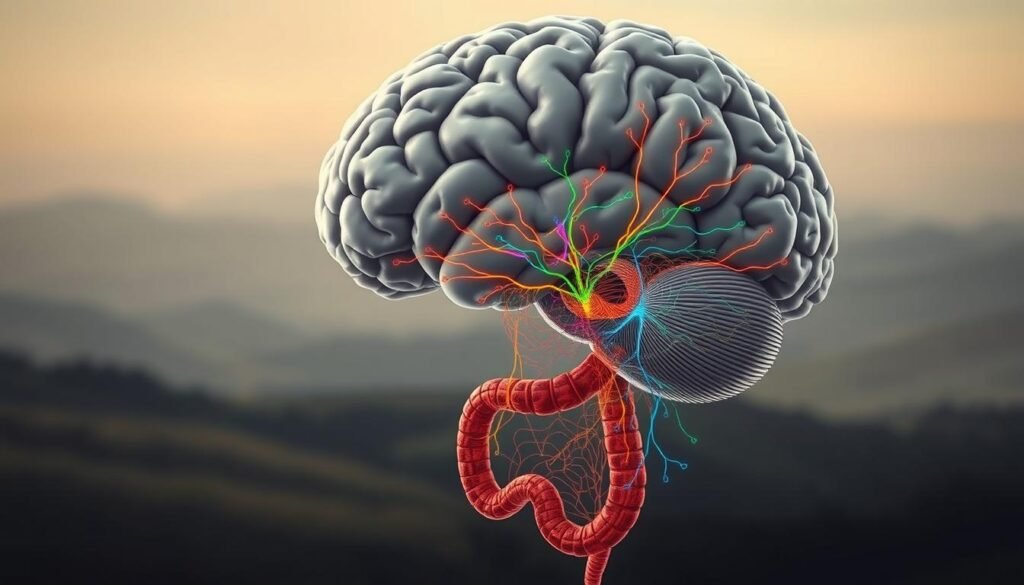Eating healthy is key to staying well and looking good. What we eat every day affects our health a lot. It changes how we feel and our risk of getting sick later on.
Thank you for reading this post, don't forget to subscribe!Eating junk food, full of bad stuff and lacking good stuff, can harm us. But, eating foods that are good for us helps our body work right and keeps us healthy.
Key Takeaways
- A healthy diet is essential for overall wellness.
- Junk food consumption is linked to negative health outcomes.
- Nutrition plays a crucial role in maintaining bodily functions.
- Dietary choices significantly impact energy levels and disease risk.
- A balanced diet supports long-term health and well-being.
What Defines Healthy Food and Junk Food
Knowing the difference between healthy and junk food is key to good eating habits. The foods we pick greatly affect our health and happiness.
Characteristics of Nutrient-Dense Healthy Foods
Healthy foods are packed with vitamins, minerals, and good stuff. They include fresh fruits, vegetables, whole grains, lean proteins, and healthy fats. These foods help our bodies work at their best.
Identifying Processed Junk Foods and Their Components
Junk foods, however, are full of calories, added sugars, salt, and unhealthy fats. They’re often made and packaged quickly, but they’re not good for us.
The Nutritional Value Comparison
| Nutritional Aspect | Healthy Foods | Junk Foods |
|---|---|---|
| Calorie Density | Low to Moderate | High |
| Nutrient Content | Rich in Vitamins and Minerals | High in Added Sugars and Salt |
| Processing Level | Minimally Processed | Heavily Processed |
Choosing the right foods is about understanding these differences. Opt for nutrient-dense foods for the best health.
How Your Food Choices Affect Your Body Immediately
What we eat greatly affects our body’s responses. It impacts how we digest food and our energy levels. Our diet choices have immediate effects on our body’s functions.
Energy Production and Daily Performance
The food we eat is key to energy production. Eating foods like whole grains, fruits, and veggies gives us energy all day. But, sugary foods can give a quick energy boost followed by a crash, hurting our daily performance.

Digestive Response to Different Food Types
Different foods cause different digestive responses. Foods like legumes and whole grains help digestion. But, processed and high-fat foods can cause discomfort, like bloating and indigestion.
Blood Sugar Fluctuations and Their Effects
Blood sugar fluctuations happen right after we eat. Foods with a high glycemic index quickly raise blood sugar levels.
The Crash and Burn Cycle of Sugary Foods
Eating sugary foods starts a cycle of energy ups and downs. They give a quick energy boost but then leave us feeling tired and wanting more sugar.
Sustained Energy from Complex Nutrients
But, complex nutrients give us steady energy. Foods like fiber, protein, and healthy fats are digested slowly. They release glucose slowly, keeping our energy up longer.
The Benefits of Eating Healthy for Long-Term Health
Eating healthy is more than just a short-term goal. It greatly improves your long-term health. A diet full of essential nutrients brings many benefits. These range from preventing chronic diseases to boosting overall wellbeing.
Reduced Risk of Chronic Diseases
One big plus of a healthy diet is lowering the risk of chronic diseases. This includes:
- Heart Disease Prevention: Eating less saturated fat and more omega-3 fatty acids can prevent heart disease.
- Cancer Risk Reduction: A diet rich in fruits, vegetables, and whole grains can lower cancer risk.
- Diabetes Management and Prevention: A balanced diet low in sugar and refined carbs helps manage and prevent diabetes.
Weight Management and Metabolic Health
A healthy diet is key for keeping a healthy weight and good metabolic health. By choosing nutrient-dense foods, you can manage your weight better. This also lowers the risk of metabolic syndrome.
Key Strategies include:
- Eating a variety of whole foods
- Limiting processed and high-calorie foods
- Staying hydrated
Enhanced Immune System Function
A well-balanced diet is also vital for a strong immune system. Nutrients like vitamin C, vitamin D, and zinc are crucial for immune health.
Foods rich in these nutrients include citrus fruits, leafy greens, and nuts. Adding these foods to your diet boosts your immune system. It also helps lower the risk of infections.
Understanding the Health Consequences of Regular Junk Food Consumption
Junk food is bad for your health because it has too many processed ingredients and not enough nutrients. Eating it often can cause many health problems. These include inflammation and addiction to food.
Systemic Inflammation and Its Effects
Eating junk food regularly can start systemic inflammation. This means your body’s immune system is always on, leading to chronic inflammation. This can make diseases like arthritis and heart disease worse. Dr. Andrew Weil says, “Chronic inflammation is a big problem in many diseases, and what we eat is very important.”

The Science Behind Food Addiction
Junk food is made to be very tasty, which can make you addicted to it. This happens because of how your brain works, especially with dopamine. Knowing this can help you fight cravings and avoid addiction.
Hidden Health Costs Despite Feeling Full
Even though junk food makes you feel full, it has hidden health risks. These include not getting enough nutrients and eating too much sodium, sugar, and unhealthy fats.
Micronutrient Deficiencies
Eating junk food too much can make you miss out on important vitamins and minerals. This can hurt how your body works, like making energy and fighting off sickness.
Excess Sodium, Sugar, and Unhealthy Fats
Junk foods have a lot of sodium, sugar, and unhealthy fats. Eating too much of these can increase your risk of high blood pressure, diabetes, and heart disease. It’s important to watch what you eat to stay healthy.
In short, eating junk food often can harm your health in many ways. Knowing these risks and making smart food choices can help avoid these problems.
How Your Diet Transforms Your Physical Appearance
Your diet is key in shaping your look. It affects your skin, hair, and muscles. The food you eat gives your body what it needs to look its best.
Nutrition’s Impact on Skin Health and Aging
Eating foods full of antioxidants, vitamins, and minerals can make your skin better. Foods like citrus fruits and berries boost collagen, making your skin look smoother. But, eating too much processed food and sugar can make your skin age faster.
Dietary Influences on Hair Strength and Growth
Protein, iron, and biotin are important for your hair. Eating foods like lean meats, fish, and eggs helps your hair grow stronger. Not getting enough of these nutrients can cause hair loss and make your hair weak.
Food Choices That Shape Body Composition
What you eat directly affects your body shape. It impacts your muscles and how fat is stored.
Muscle Development and Maintenance
Enough protein is vital for building and keeping muscles. Foods like lean meats, dairy, and legumes help your muscles grow and repair.
Fat Distribution and Storage
The fats you eat can change how fat is stored in your body. Omega-3s in fish and nuts can help reduce inflammation, which might affect fat storage.
| Nutrient | Food Sources | Impact on Physical Appearance |
|---|---|---|
| Vitamin C | Citrus fruits, berries | Enhances skin health, promotes collagen production |
| Protein | Lean meats, fish, eggs, legumes | Promotes muscle development, strengthens hair |
| Omega-3 Fatty Acids | Fish, nuts, seeds | Reduces inflammation, influences fat distribution |
Choosing the right foods can greatly improve how you look. It can make your skin better, help your hair grow, and shape your body.
The Brain-Gut Connection: How Food Affects Mental Health
The food we eat greatly affects our mental health. This is because of the connection between our gut and brain. This connection shows how diet impacts our thinking, feelings, and mental health.

Nutrients Essential for Cognitive Function
Eating foods rich in nutrients is key for a healthy brain. Omega-3 fatty acids in fish and nuts help our brain. Antioxidants in fruits and veggies protect our brain from damage. Also, B vitamins and magnesium are important for making neurotransmitters and keeping our brain cells working well.
How Diet Influences Neurotransmitter Production
What we eat affects how our brain makes neurotransmitters like serotonin and dopamine. These chemicals help us feel good and manage our emotions. Amino acids, found in proteins, are what our brain uses to make these neurotransmitters. For example, tryptophan turns into serotonin, which affects our mood.
Eating Patterns That Support Emotional Wellbeing
Some eating habits can help our emotional health by keeping our gut healthy and blood sugar stable. Anti-inflammatory diets are full of whole foods and fiber. They help lower inflammation, which is linked to mental health issues.
Anti-inflammatory Diets and Depression
Studies show that anti-inflammatory diets can help with depression. They reduce inflammation and support a healthy gut-brain connection. Foods rich in omega-3 fatty acids and antioxidants are especially good.
Blood Sugar Stability and Anxiety
Keeping blood sugar steady is important for managing anxiety. Complex carbohydrates and fiber-rich foods help control blood sugar. This reduces anxiety. It’s also good to avoid sugary and processed foods to prevent blood sugar spikes.
By learning about the brain-gut connection and making smart food choices, we can improve our mental health and overall wellbeing.
Optimizing Sleep Quality Through Dietary Choices
Diet and sleep are closely linked. Certain foods and eating habits can greatly affect how well you sleep. Eating right can help you sleep better, while bad eating habits can make it harder.
Sleep-Promoting Foods and Nutrients
Some foods and nutrients help you sleep better. These include:
- Tryptophan-rich foods like turkey and chicken, which help produce serotonin and melatonin.
- Complex carbohydrates such as whole grains, which increase serotonin levels.
- Calcium-rich foods like milk, which help the brain use tryptophan to produce melatonin.

Eating Habits That Disrupt Sleep Architecture
Some eating habits can harm your sleep. These include:
- Consuming heavy meals close to bedtime, which can cause discomfort and indigestion.
- Eating foods high in sugar, which can lead to energy crashes and disrupt sleep patterns.
- Drinking caffeine and alcohol in the hours leading up to bedtime, both of which can interfere with sleep.
Creating a Sleep-Supportive Meal Schedule
To improve sleep, plan your meals and snacks wisely. Here are some tips:
| Meal Timing | Food Choices |
|---|---|
| Dinner | Include tryptophan-rich foods and complex carbohydrates. |
| Evening Snack | Opt for a small, light snack that includes calcium. |
| Before Bedtime | Avoid heavy, sugary, caffeinated, and alcoholic beverages. |
Making smart food choices and following a sleep-friendly meal plan can greatly improve your sleep.
“A good laugh and a long sleep are the best cures in the doctor’s book.”
How to Build a Balanced Diet for Optimal Health
A well-balanced diet is key to a healthy life. It affects both your body and mind. To achieve optimal health, you need to know about nutritional balance and make smart food choices.
Incorporating Quality Protein Sources
Protein is crucial for a balanced diet. It helps build and repair tissues. Eating a variety of protein sources ensures you get all the amino acids you need.
Plant-Based Options
Plant-based proteins like beans, lentils, and tofu are full of protein and fiber. They are also rich in other nutrients. You can add them to many meals.
Animal-Based Options
Animal proteins like chicken, fish, and eggs offer high-quality protein and important nutrients. Choose lean cuts and vary your sources for a balanced diet.
Selecting the Right Carbohydrates for Sustained Energy
Carbohydrates give your body energy. Choose complex carbs like whole grains, fruits, and veggies for lasting energy and fiber.
“The food you eat can either be the safest and most powerful form of medicine, or the slowest form of poison.” – Ann Wigmore
Including Essential Fatty Acids in Your Diet
Essential fatty acids, like omega-3 and omega-6, are vital for heart health and brain function. Find them in fatty fish, nuts, and seeds.
Maximizing Micronutrient Intake Through Diverse Produce
Eating a variety of fruits and veggies is key for vitamins and minerals. Try to eat foods of all colors to get a wide range of nutrients.
By focusing on these areas, you can create a balanced diet that supports your health and wellbeing.
Step-by-Step Guide to Transitioning From Junk Food to Healthy Eating
Starting a healthy eating habit is a journey. It involves understanding and using several key strategies. This guide will help you change your eating habits in six weeks.
Week 1-2: Initial Food Swaps and Pantry Reset
The first step is to swap junk food for healthier options and reset your pantry. Start by replacing junk food with better choices. For example, try baked sweet potato fries instead of potato chips.
- Swap sugary drinks for infused water or unsweetened tea.
- Choose whole grain bread over white bread.
- Go for baked or grilled foods instead of fried ones.
Week 3-4: Implementing Meal Planning Strategies
Meal planning is key to a healthy diet. It helps you avoid unhealthy choices at the last minute.
“Meal planning is the key to a healthy and stress-free week.” –
Plan meals around seasonal produce for freshness and variety.
| Meal | Healthy Option | Junk Food Alternative |
|---|---|---|
| Breakfast | Oatmeal with fruits | Sugary cereal |
| Lunch | Grilled chicken salad | Fast food burger |
| Dinner | Baked salmon with vegetables | Fried chicken |
Week 5-6: Developing Techniques to Manage Cravings
Managing cravings is crucial for a healthy diet. It involves understanding emotional triggers and finding healthy comfort food alternatives.
Identifying Emotional Triggers
Knowing why you crave certain foods helps manage those cravings. Keep a food diary to track your habits and find patterns.
Find healthier versions of your favorite comfort foods. For example, make a healthier pizza at home with a whole-wheat crust and lots of veggies.
- Use cauliflower for a low-carb pizza crust.
- Choose air-popped popcorn over chips.
- Make a healthier mac and cheese with whole grain pasta and low-fat cheese.
By following this guide, you can move from junk food to healthy eating. This will improve your health and wellbeing.
How to Decode Food Labels and Make Informed Choices
Learning to read food labels is crucial for healthier eating. With so much info on packaging, knowing what to look for is essential. This helps you make better choices.
The First 5 Ingredients: What They Tell You
The first five ingredients on a label reveal a lot about the food. They list items in order of how much is in the product. Look for whole foods like veggies, fruits, and grains at the top. If sugars or refined grains are first, it might not be as healthy.
Analyzing Nutrition Facts for Hidden Sugars and Fats
The Nutrition Facts panel is key to understanding a food’s nutritional value. Watch out for sugar and fat amounts. Sugars can be hidden under names like high fructose corn syrup. Fats might be called partially hydrogenated oils. Also, check the serving size to understand the nutrition data better.
Recognizing Misleading Health Claims and Marketing
Food companies use health claims and marketing to make products seem better. Be cautious of terms like “all-natural” or “low-fat.” Knowing the real meaning behind these terms helps you make better choices.
Understanding “Natural” vs. “Organic” Labels
“Natural” is not strictly regulated, but “organic” has clear standards. “Organic” means no synthetic fertilizers, pesticides, or GMOs. Choosing “organic” usually means you’re getting a product made with healthier methods.
The Truth Behind “Low-Fat” and “Sugar-Free” Products
“Low-fat” products might have more sugars, and “sugar-free” ones could have artificial sweeteners. Always check the Nutrition Facts and ingredient list. This way, you get a real view of the product’s nutritional value.
Eating Healthy on a Budget: Practical Money-Saving Strategies
It’s possible to eat healthy without spending too much. With some planning and knowledge, you can enjoy nutritious food without breaking the bank.
Seasonal Shopping Guide for Maximum Nutrition and Value
Shopping for food when it’s in season is a smart move. Produce that’s in season is cheaper and tastes better. For instance, buying berries in summer or apples in fall can save you money. Seasonal shopping also means you get the freshest food.
Smart Bulk Purchasing and Preservation Methods
Buying in bulk can also help you save. Items like grains, nuts, and dried fruits are cheaper in large quantities. To keep your bulk buys fresh, use preservation methods like freezing, canning, or dehydrating.
Cost-Benefit Analysis: Prevention vs. Treatment
Choosing healthy food can save you money in the long run. A cost-benefit analysis shows that eating well can prevent expensive illnesses. By eating right, you can avoid chronic diseases and save thousands on medical bills.
In summary, eating healthy on a budget is doable. Strategies like seasonal shopping, bulk buying, and understanding the benefits of prevention can help. These methods allow you to enjoy healthy meals while keeping your finances in check.
Navigating Social Eating While Maintaining Healthy Choices
It’s important to have a plan when eating out with friends or at family gatherings. Making healthy choices can be tough, but it’s doable with the right mindset.
Restaurant Ordering Strategies for Healthier Meals
First, review the menu before you go. Choose dishes that are grilled, baked, or steamed. Avoid fried foods and heavy sauces. You can also ask for changes, like dressing on the side or swapping sides for a salad.
Handling Food-Centered Social Events
At gatherings, it’s easy to overeat. Plan ahead by eating a healthy meal before you go. This way, you won’t be tempted by unhealthy foods. If you’re hosting, serve dishes that are both healthy and tasty for your guests.
Balancing Special Occasions with Everyday Nutrition
It’s okay to treat yourself sometimes, but balance is key. After a big event, get back to your usual healthy eating. Adding physical activity can also help balance out extra calories.
Being mindful and planning ahead lets you enjoy social eating while staying healthy.
Developing Sustainable Healthy Eating Habits for Life
Creating lasting healthy eating habits takes commitment and planning. It’s about choosing foods that are good for your body and mind. Sustainable eating is more than just diet; it’s a lifestyle that boosts health and happiness.
Implementing the Flexible 80/20 Approach
The 80/20 approach is a smart way to eat healthy. It means eating nutritious foods 80% of the time and enjoying less healthy options 20% of the time. This balance makes it easier to follow a healthy diet.
Cultivating Mindful Eating Practices
Mindful eating is about listening to your body’s hunger and fullness signals. It’s about enjoying your food and eating slowly. This can help you avoid overeating and improve your food relationship.
Creating a Supportive Food Environment at Home
Having a supportive food environment at home is key to lasting healthy habits. This means planning meals, shopping wisely, and preparing healthy foods.
Family Meal Planning Strategies
Family meal planning helps ensure everyone eats well. It involves planning meals ahead, making a shopping list, and cooking together. This approach makes mealtime more enjoyable and healthy.
| Meal Planning Tips | Benefits |
|---|---|
| Plan meals around seasonal produce | Ensures freshness and variety |
| Involve the family in meal planning | Promotes engagement and satisfaction |
| Make a grocery list | Reduces food waste and saves money |
Teaching Children About Nutrition Through Example
Teaching kids about nutrition works best when you show them. Parents can set a good example by eating healthy and involving kids in meal planning and cooking.
Conclusion: Taking Control of Your Health Through Food Choices
Eating well is key to a healthy body and mind. Knowing the difference between healthy and junk food is the first step to a balanced diet.
Healthy eating is more than just avoiding junk food. It’s about choosing foods that give you energy and help you stay healthy for a long time. Adding quality protein, the right carbs, and essential fats to your diet boosts your nutrition.
Changing your diet for better health takes dedication and knowledge. Being careful about what you eat and adopting healthy habits can lower disease risks. Start making better food choices today to improve your health and wellbeing.
FAQ
What are the immediate effects of consuming junk food on the body?
Eating junk food quickly raises your blood sugar. Then, it drops, making you feel tired. It also causes stomach discomfort because of unhealthy fats and sodium.
How does a healthy diet impact mental health?
Eating well supports your brain and mood. It helps make neurotransmitters that can lift your spirits and reduce anxiety and depression.
What are some strategies for transitioning from junk food to healthy eating?
Start by swapping unhealthy snacks for fruits or nuts. Plan your meals and slowly add healthier foods. To fight cravings, know what triggers them and find better comfort foods.
How can I eat healthy on a budget?
Buy produce in season to save money and get more nutrients. Buying in bulk and preserving food can also help. Think about the long-term savings of eating healthy instead of dealing with diet-related illnesses.
What are some tips for navigating social eating while maintaining healthy choices?
Choose grilled or baked foods when eating out. Bring a healthy dish to share at gatherings. Make healthier choices most of the time to balance out special occasions.
How can I develop sustainable healthy eating habits?
Follow the 80/20 rule to make healthy eating easier. Eat well 80% of the time and enjoy treats 20% of the time. Practice mindful eating and create a healthy food environment at home.
What are the benefits of a balanced diet for overall health?
Eating well can lower the risk of heart disease, cancer, and diabetes. It helps with weight control, boosts your immune system, and improves your physical and mental health.
How do I decode food labels to make informed choices?
Check the first five ingredients to see what’s in the product. Look at nutrition facts for hidden sugars and fats. Be cautious of misleading health claims and know the difference between “natural” and “organic.”
Can dietary choices affect sleep quality?
Yes, some foods can help or hurt your sleep. Eat sleep-promoting foods and avoid heavy meals before bed. A sleep-friendly meal plan can also help.
How does diet influence physical appearance?
What you eat affects your skin, hair, and muscles. A diet full of nutrients supports healthy skin and hair. But, a diet rich in processed foods can harm your appearance.
